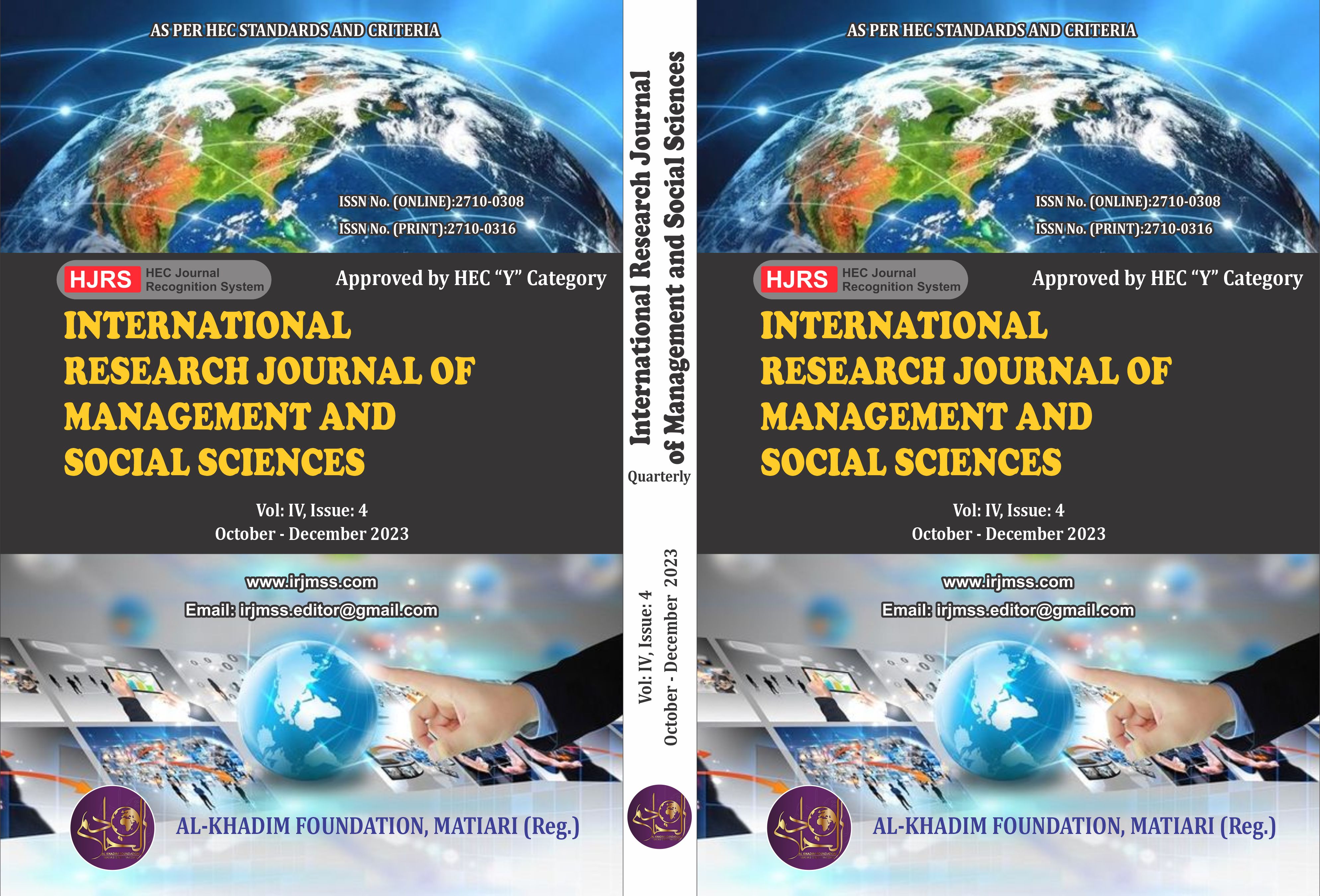Educational Problems at College Level Effacing Quality of Education in Government Colleges of Sindh Province: Teachers’ Opinions A case study of Mirpurkhas region
Keywords:
Academic Facilities, Institutional Problems, Quality Education, Secondary EducationAbstract
The principal objective of this investigation was to assess the institutional challenges impacting the quality of college level education institutions within the Sindh province of Pakistan. Employing a quantitative survey approach, the study specifically focused on evaluating the College Education (CE) system in Sindh. The target group included 840 College Teachers employed in public colleges under the Sindh College Education Department (SCED) in the Mirpurkhas Region. A representative sample of 180 College Teachers, covering all 31 colleges in the region, was deemed appropriate for the study. Data collection utilized a questionnaire with a 5-point Likert scale, consisting of two sections: Part A with 12 closed-ended questions and Part B featuring an open-ended question. Collection methods included personal visits to colleges and phone interviews. Descriptive and inferential statistics, including percentages and mean scores, were applied for data analysis.
Findings: Upon thorough data analysis, the study unveiled deficiencies within the SCED system. These included the presence of unskilled teachers, teacher dissatisfaction arising from media scrutiny, and instances of non-professional conduct by Principals. Additional concerns encompassed issues related to general and academic facilities, inappropriate curricula, a shortage of subject teachers, budgetary constraints in colleges, the low status of secondary education, unskilled Principals, and delayed promotions for Teachers.
Improvements: To address these challenges, the study recommends implementing a concise training course for teachers, coupled with acknowledgment and appreciation of their efforts. Additional suggestions include ensuring adequate general and academic facilities, fostering an optimal educational environment, simplifying curricula formats, ensuring timely promotions for teachers, enhancing the overall quality of secondary education, promoting effective management practices, and providing professional training to Principals to improve both curricular and administrative affairs
References
Ball DL. Prospective elementary and secondary teachers’ understanding of division. Journal of Research in Mathematics Education. 1990; 21;132–44. https://doi. org/10.2307/749140
National Policy on Education [Internet]. [cited 2019 Apr 02]. Available from: https://en.wikipedia.org/wiki/ National_Policy_on_Education.
Zafar M. Fiscal devolution in education: Case study reflecting initial responses. Ministry of education; 2003. p. 34–41.
Pakistan Education Statistics 2015-16 [Internet]. [cited 2017 Feb 28]. Available from: https://reliefweb.int/report/ pakistan/pakistan-education-statistics-2015-16.
Shami A. Development of education in Pakistan. Academy of Educational Planning and Management. Ministry of Education; 2005. p. 8–88.
Chaudhari P. Secondary Education in India: Issues and Concerns. International Journal of Social Science and Humanities Research. 2016; 4(1):300–5.
Highlights: Pakistan Economic Survey 2017-18 [Internet]. [cited 2018 Apr 27]. Available from: https://www.brecorder. com/2018/04/27/414437/highlights-of-pakistan-economic-survey-2017-18/.
Malik R. The system of education in Pakistan. National Book Foundation; 2000. p. 1–43.
Factors influencing teacher’s performance and retention [Internet]. [cited 2015 Jan]. Available from: https:// www.researchgate.net/publication/271721909_Factors_ Influencing_Teachers’_Performance_and_Retention.
Ahmed. Critical analysis of education in Pakistan: possible solutions. International Journal of Evaluation and Research in Education. 2014; 2(2):79–84. https://doi.org/10.11591/ ijere.v3i2.1805
Fayyaz H. Major issues of education sector in Pakistan. International Journal of Academic Research in Progressive Education and Development. 2014; 3(4):361–76. https:// doi.org/10.6007/IJARPED/v3-i4/1366
Park JH, Jeong DW. School reforms, principal leadership, and teacher resistance: Evidence from Korea. Asia Pacific Journal of education. 2013; 33(1):34–52. https://doi.org/10.
1080/02188791.2012.756392
Identification of the problems faced by secondary school teachers in Kohat Division, Pakistan [Internet]. [cited 2012 Nov]. Available from: https://www.researchgate.net/ publication/276025541_Identification_of_the_Problems_ Faced_by_Secondary_School_Teachers_in_Kohat_
Division_Pakistan.
Critical analysis of problems of school teachers in Pakistan: Challenges and possible solutions [Internet]. [cited 2013]. Available from: https://www.iiste.org/Journals/index.php/ JEP/article/view/4532.
Quality school education in Pakistan: Challenges, successes and strategies [Internet]. [cited2011 Jan]. Available from: https://www.researchgate.net/publication/258047276_ QUALITY_SCHOOL_EDUCATION_IN_PAKISTAN_ CHALLENGES_SUCCESSES_AND_STRATEGIES.
Sindh education management information system
[Internet]. [cited 2017]. Available from: file:///C:/Users/a/ Downloads/Sindhi+hariduse+haldamise+infos%C3%BCst eemi+anal%C3%BC%C3%BCs.pdf. Date accessed:
Causes of decline of education in Pakistan and its remedies [Internet]. [cited 2010 Aug 01]. Available from: https:// clutejournals.com/index.php/TLC/article/view/139.
Memon GR. Education in Pakistan: The key issues, problems and the new challenges. Journal of Management and Social Sciences. 2007; 3(1):47–55.
Quality Primary Education in Pakistan [Internet]. [cited 2016 Dec 27]. Available from: https://atlascorps.org/ quality-of-primary-education-in-pakistans-rural-areasresults-from-annual-status-of-education-report-aser/.
Research design: Qualitative, quantitative and mixed methods approaches [Internet]. [cited 2003]. Available from: file:///C:/ Users/a/Downloads/[Creswell,_J.]_Research_design_ Qualitative,_Quant(b-ok.xyz)%20FOURTH%20ED.pdf.
Arshad M, Qamar AZ, Gulzar HF. Effects of physical facilities at public schools on students’ achievement in Punjab, Pakistan. Global Social Sciences Review. 2018; 3(4):102–13.
https://doi.org/10.31703/gssr.2018(III-IV).07
Minimum standards for quality education in Pakistan: Attaining standards for improved learning outcomes and school outcome [Internet]. [cited 2013]. Available from: http://planipolis.iiep.unesco.org/en/2016/minimum- standards-quality-education-pakistan-attaining-standards-improved-learning-outcomes-and.
Why teachers need a staff room [Internet]. [cited 2012 Apr 09]. Available from: https://www.theguardian.com/ education/shortcuts/2012/apr/09/why-teachers-need-astaff-room.
Ahmad G, Arshad M, Qamar AZ, Gulzar HF. Influence of school environment on students outcomes at secondary level. American Based Research Journal. 2018; 7(12):16–23.
Ministry of Education [Internet]. [cited 2019]. Available from: http://moe.gov.tt/.
Annual Status of Education Report: ASER-Pakistan 2018 [Internet]. [cited 2019]. Available from: https:// learningportal.iiep.unesco.org/en/library/annual-statusof-education-report-aser-pakistan-2018-national.
Experts blame poor management for Sindh’s education woes [Internet]. [cited 2015 Jan 24]. Available from: https:// www.thenews.com.pk/print/20139-experts-blame-poormanagement-for-sindhs-education-woes.






